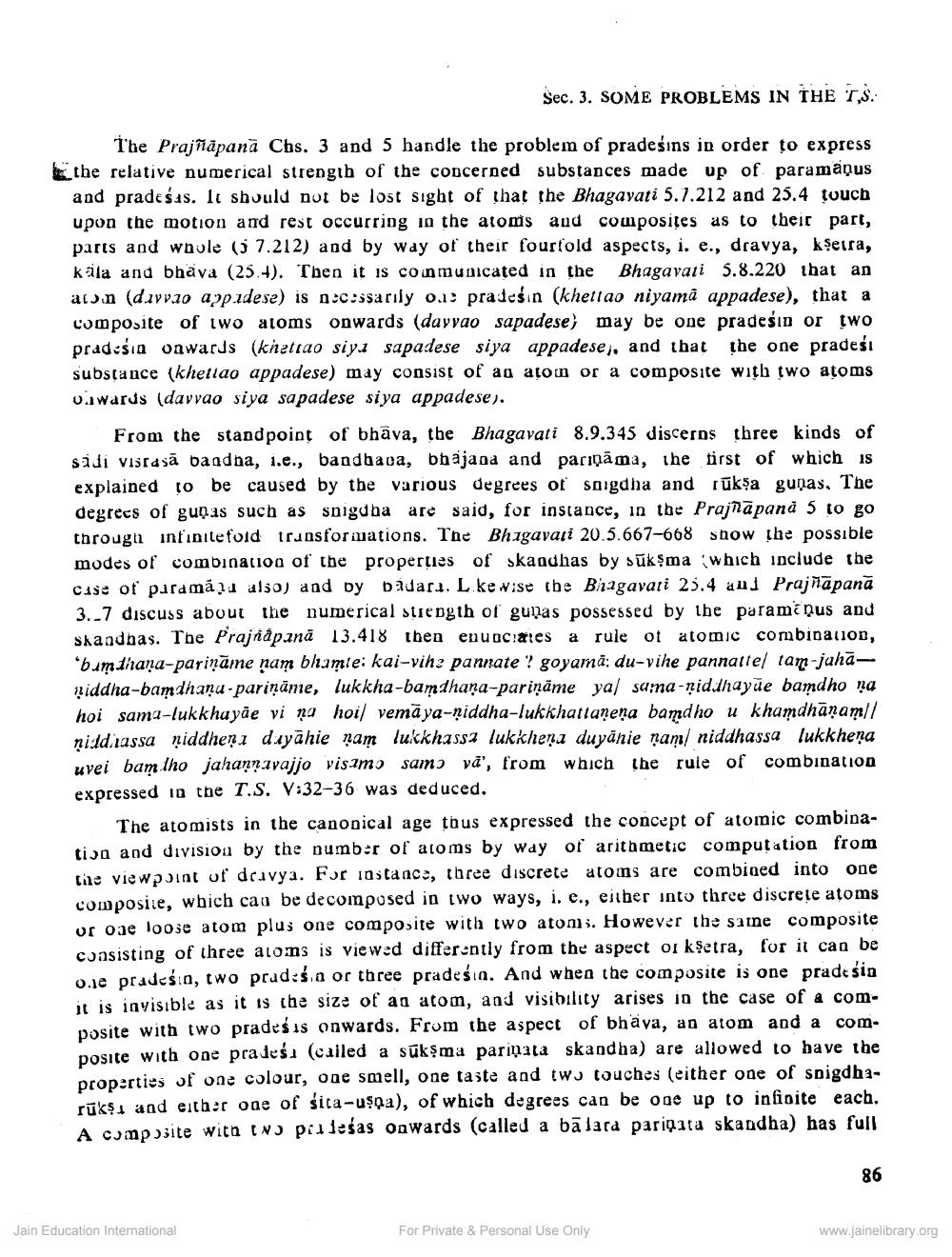________________
Sec. 3. SOME PROBLEMS IN THE TS.
The Prajnapana Chs. 3 and 5 handle the problem of pradesins in order to express the relative numerical strength of the concerned substances made up of paramapus and pradesas. It should not be lost sight of that the Bhagavati 5.7.212 and 25.4 touch upon the motion and rest occurring in the atoms and composites as to their part, parts and whole (3 7.212) and by way of their fourfold aspects, i. e., dravya, kṣetra, kala and bhava (25.4). Then it is communicated in the Bhagavati 5.8.220 that an aton (davvao appadese) is n:o:ssarily oa: pradesin (khettao niyama appadese), that a composite of two atoms onwards (davvao sapadese) may be one pradesin or two pradesin onwards (khettao siya sapadese siya appadese,, and that the one pradesi substance (khetiao appadese) may consist of an atom or a composite with two atoms oawards (davvao siya sapadese siya appadese).
From the standpoint of bhäva, the Bhagavati 8.9.345 discerns three kinds of sadi vistasa baadna, i.e., bandhana, bhajana and parama, the first of which is explained to be caused by the various degrees of snigdha and ruksa gupas. The degrees of gunas such as snigdha are said, for instance, in the Prajnapana 5 to go through infinitefold transformations. The Bhagavati 20.5.667-668 show the possible modes of combination of the properties of skandhas by sukṣma (which include the case of paramaga also) and by badara. L.kewise the Bhagavati 25.4 and Prajñāpanā 3.7 discuss about the numerical strength of gupas possessed by the paramous and Skandhas. The Prajñāpanā 13.418 then enunciates a rule of atomic combination, "bamdhana-pariņāme nam bhamie: kai-vihz pannate? goyama: du-vihe pannattel tam-jahasiddha-bamdhana-pariname, lukkha-bamdhana-pariņāme ya sama-niddhayae bandho ya hoi sama-lukkhayde vi na hoi vemaya-ṇiddha-lukkhattanena bandho u khamdhāṇam// giddaassa niddhena dayahie nam lukkhassa lukkheya duyanie nam niddhassa lukkheņa uvei bam tho jahannavajjo visamɔ samɔ va', from which the rule of combination expressed in the T.S. V:32-36 was deduced.
The atomists in the canonical age thus expressed the concept of atomic combination and division by the number of atoms by way of arithmetic computation from the viewpoint of dravya. For instance, three discrete atoms are combined into one composite, which can be decomposed in two ways, i. c., either into three discrete atoms or oae loose atom plus one composite with two atoms. However the same composite consisting of three atoms is viewed differently from the aspect of kṣetra, for it can be one pradesin, two prades.a or three pradesin. And when the composite is one pradesin it is invisible as it is the size of an atom, and visibility arises in the case of a composite with two prades is onwards. From the aspect of bhava, an atom and a composite with one prades (called a sükṣma paripata skandha) are allowed to have the properties of one colour, one smell, one taste and two touches (either one of snigdharūks and either one of sita-uspa), of which degrees can be one up to infinite each. A composite with two pralesas oawards (called a balara paripata skandha) has full
Jain Education International
For Private & Personal Use Only
86
www.jainelibrary.org




